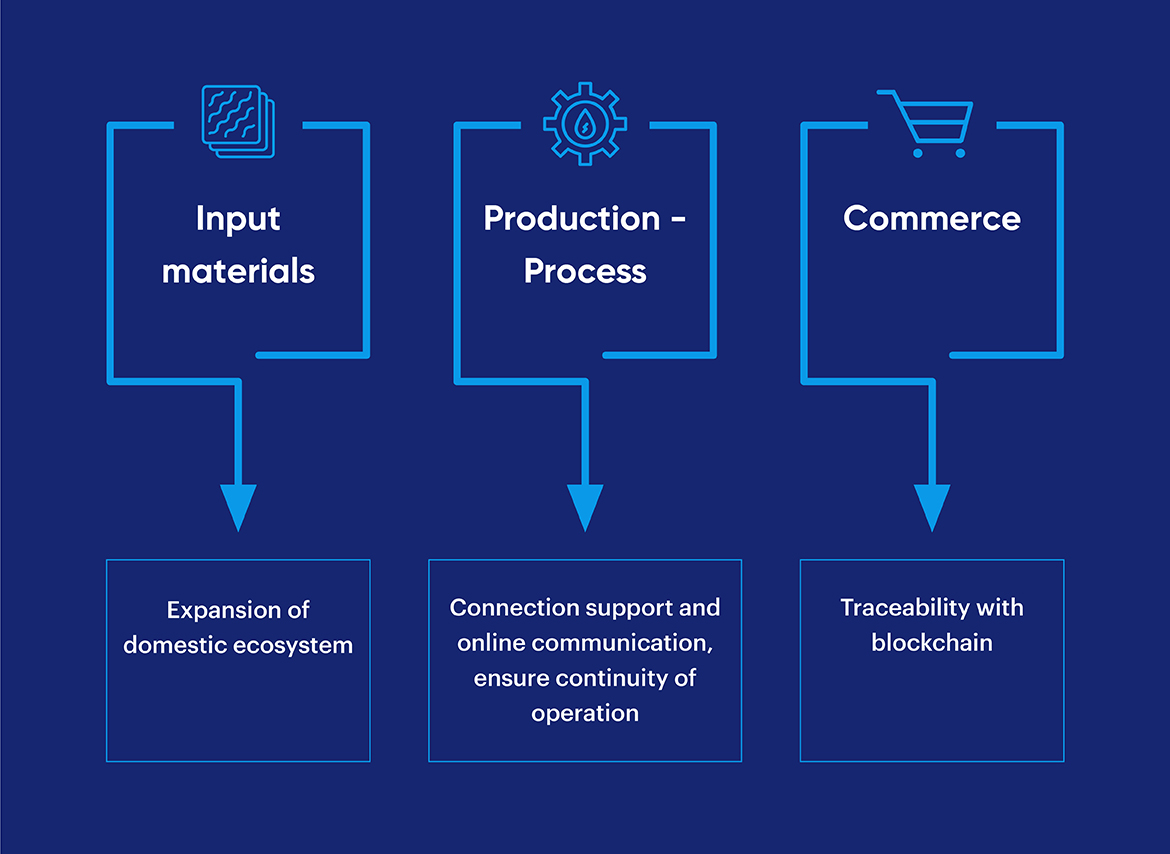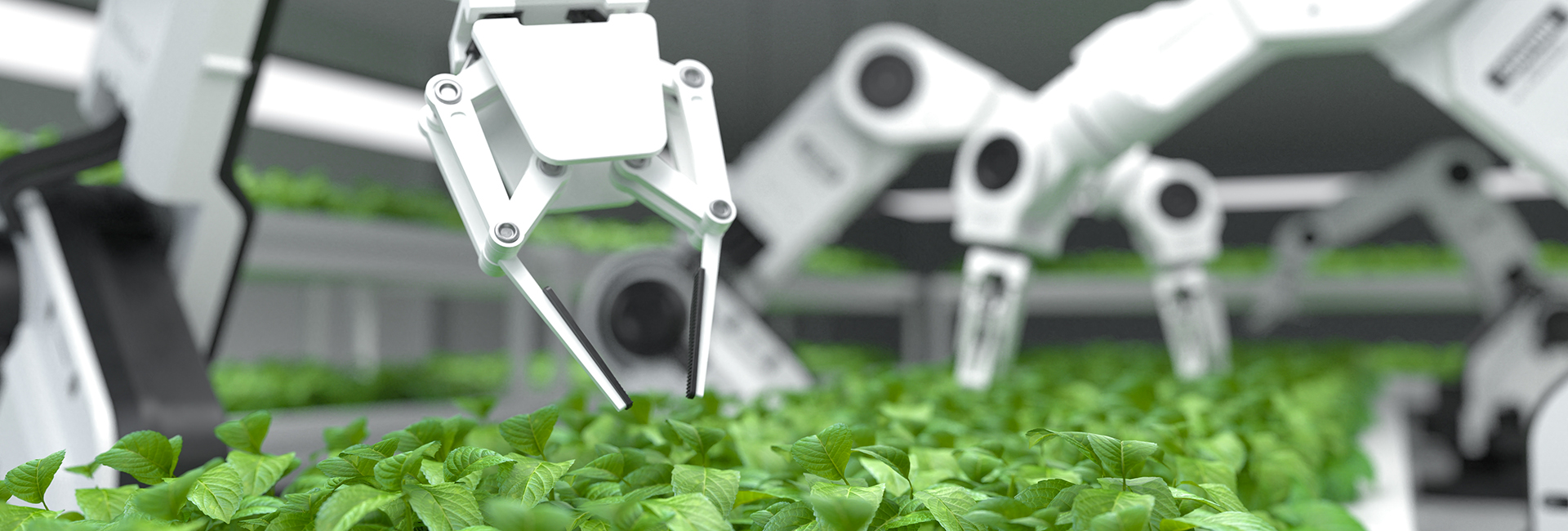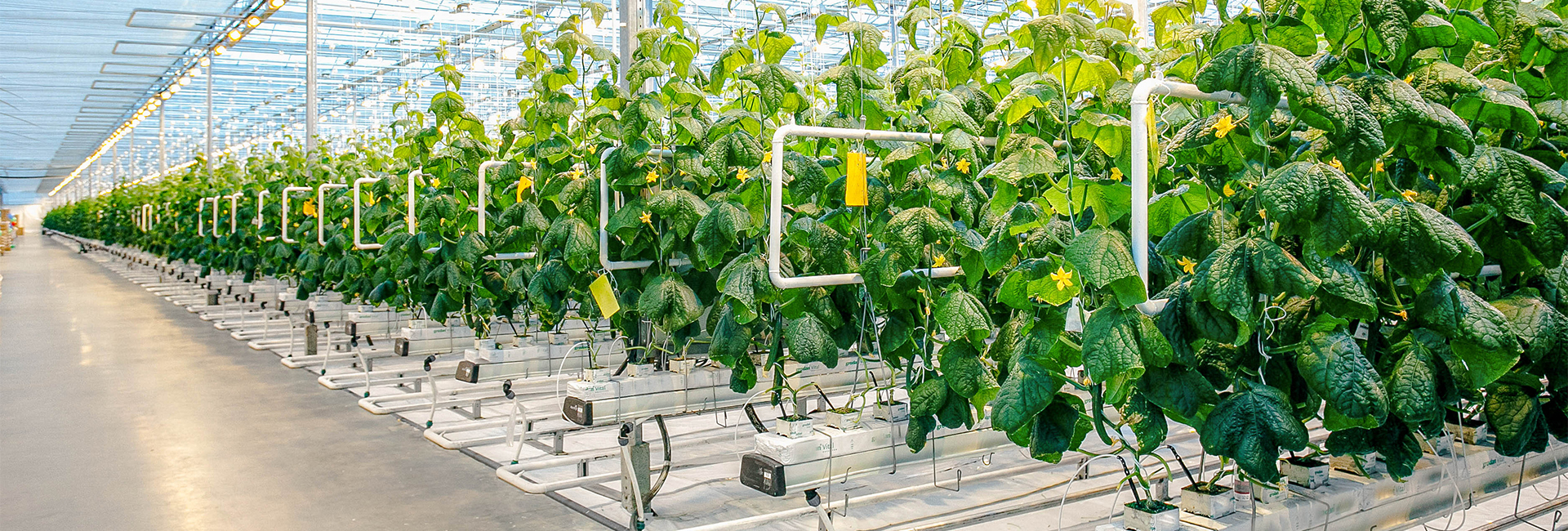Digital transformation in agriculture is described as the process of applying technical instruments from production to processing, distribution, and consumption of products. Significantly, the application of technology techniques is a key distinction between modern agriculture and traditional agriculture.
In order to create a new vegetable growing model in Vietnam, FPT Corporation collaborated with Japanese experts, the Fruit and Vegetable Research Institute, Fujitsu, and local Vietnamese farmers. To be more precise, this model uses Akisai technology to connect and control farm equipment remotely – the computerized monitoring and control of the greenhouse’s atmosphere ensure that lettuce and tomato plants can develop in the ideal conditions.
1. What tasks are included in agricultural digital transformation?
Agricultural digital transformation includes basic tasks such as applying contemporary technologies in farming, linking value chains and modifying activity management. As follows:
1.1. Apply contemporary technologies in agricultural farming
In current, there are numerous contemporary technologies applied in agricultural farming, in which the prominents are IoT and field sensors, machine learning and analytics, and drones to monitor crops.
IoT and field sensors
When it comes to applying this technology, the machine system surrounding the field will be equipped with sensors and connected to the internet. It requires careful planning to deploy the sensor in a location that can cover the entire area. As a result, the grower is then able to comprehend the tree’s condition and make the appropriate adjustments.
- The device system will automatically water and provide nutrients to the plants corresponding to the grower’s control.
- The sensor is integrated with image recognition technology to help growers monitor and observe tree status from afar.
- The sensor gathers and continuously updates real-time data about the tree in order to provide it to the grower. Figure 1: Applying IoT and field sensors is one of the most popular agricultural digital transformation activities. 1.1.2. Machine learning and analytics

Machine learning and analytics
Besides IoT and field sensors, the farmer can also apply machine learning and analytics in agriculture. Indeed, machine learning and analytics are considered among the most creative agricultural digital transformations since they play an important role in exploiting existing data to forecast future trends. Machine learning can anticipate the optimal characteristics and genes based on local production and climate facts. Additionally, this system forecasts the market’s top- and bottom-performing products, hence farmers are able to select appropriate crops to cultivate.
Drones to monitor crops
The drone resembles a little remote-controlled plane. This device is useful for a variety of purposes such as:
- Plant monitoring.
- Spray pesticides from above with great efficiency.
- Export 3-D images for soil quality forecasting as well as crop analysis and modeling.
1.2. Value Chain Linkages
Digital transformation in agriculture must organically integrate the components of the agricultural ecosystem along the value chain in addition to utilizing current technology, with the technology solution development center occupying the core position. Other elements interact with one another, assisting in the growth and enjoyment of the advantages provided by the technology solution development center.
Simultaneously, the value chain linkages also serve as a link between units, including:
- Connect people, businesses, and markets
- Connect people, businesses, and state management agencies with the market.
- In simpler terms, solving the digital transformation problems means solving connecting problems.
1.3. Modify agricultural activity management
Agricultural digital transformation is not only reflected in the application of technology in production and value chain link, but also in changing the operation management method of enterprises. For this reason, agricultural enterprises can run more efficiently, increase productivity at back-office departments and save costs.
To modify the activity management, the agricultural enterprises need to:
– Digitizing process: Digitization is required at every stage from manufacturing and harvesting to warehousing and distribution. Businesses must also improve communication with all parties involved in the agriculture sector, which will improve supply chain visibility. Moreover, the enterprise’s agricultural operating procedure is more transparent and effective.
– Optimizing administrative and human resource work: Business processes must be optimized using management software. In other words, Managers may now access vital data, assets, and warehouses, as well as oversee sales at all branches and retail locations while accounting professionals have remote work options, CRM system connections, e-invoice connections, and online tax filing capabilities…
– Modernizing farming practices: Utilizing modern technological innovations in farming enables farmers to perform greater productively and efficiently. At the same time, all stakeholders within the ecosystem are benefited.

2. Current status of Vietnamese agricultural digital transformation
Currently, in Vietnam, agricultural – forestry – fishery production is organized in three forms: households, cooperatives and enterprises. According to data from the General Statistics Office, as of 1st July 2020, Vietnam had 9,123 thousand agricultural, forestry, and fishery production units. Of which, there are over 9,108 thousand households; 7,418 cooperatives; 7,471 enterprises. These are the units that will directly participate in the agricultural digital transformation in our country. Up to now, digital transformation solutions in agriculture and technology have been applied in many fields such as cultivation, animal husbandry, forestry and fisheries.
– Cultivation field: IoT technology and Big Data have been applied through software to analyze the environment, type and growth stage of trees, hence consumers can trace the root and monitor its growth in real time.
– Animal husbandry field: IoT, biology, and blockchain technologies are widely applied in livestock farms.
– Forestry field: While GIS technology and remote sensing images are used to design monitoring software, early detection software for deforestation and forest degradation, and software for early detection and warning of forest fires from sanitary images, barcoding DNA technology is applied to the management of forest varieties and forest products.
– Fisheries field:
+ Technology applications in aquaculture: biofloc technology, circulating aquaculture technology (RAS), nanotechnology, artificial intelligence (AI) technology.
+ Technology application in managing offshore fishing fleets: Flow meters, ultrasonic fish detectors, vertical seine net receivers, sanitary phones, global positioning systems (GPS), capture and drop net capture system, GIS technology.
+ Technology application in seafood processing: Automation technology.
According to the Central Steering Committee for the Rural Census, Agriculture and Fisheries, digital transformation solutions in agricultural, forestry, and fishery production such as greenhouse and net house usage have been implemented in many local regions, typically Hanoi, Hue, Da Nang, Ho Chi Minh, Lam Dong.
On 1st July 2016, Vietnam had 5,897.5 hectares of greenhouses, net houses, and greenhouses in 327 communes. Among them, 2,854.3 ha (48.4%) planted flowers; 2,144.6 hectares (36.4%) of vegetables; 661.1 ha (11.2%) of seedlings planted; and 237.5 ha (4%) of aquaculture.
The digital transformation of agriculture has facilitated connections between 9 million farming households and businesses engaged in processing and trade, 100 million consumers nationwide, and billions of users worldwide. Therefore, the small, ineffective production model of Vietnam’s agricultural industry or can give way to an advanced and value chain-linked production model.

Example of agricultural digital transformation:
Vinamilk brand, which is certified as an organic farm according to European standards, has become an outstanding and successful case in terms of agricultural digital transformation by implementing IoT technology in livestock monitoring. In particular, from food diet through every stage of care, Vinamilk cows are meticulously inspected in accordance with smart agriculture requirements, thus the volume of milk obtained is up to 23 liters/head/day.
3. Several solutions for agricultural digital transformation
Businesses are encouraged to apply a number of agricultural digital transformation solutions such as enhancing human resource quality, employing technology in land management, improving capital access, and building database platforms.
3.1. Enhancing human resource quality
Problems:
Few enterprises are participating in digital transformation. Limited human resource quality with high expertise in digital agriculture makes it difficult to access and master advanced technologies. Experts have little experience in practice. Farmers remain apprehensive about the digital transformation. The rate of labor aging in the agricultural sector is taking place rapidly. Both farmers and enterprises lack an understanding of the e-commerce business.
Solutions:
- Build e-government and digital transformation in management to propose, direct and implement effective agricultural digital transformation policies.
- Encourage enterprises and young workers to join digital transformation
- Train digital transformation experts in agriculture to be good at both theory and practice
- Strengthen communication, organize training courses, skills training for farmers.
- Train residents on using trading platforms to promote products.
- Connect organizations such as Women’s Union, Farmers’ Union and cooperatives to help each other in the process of technology adoption.
- Encourage residents to use modern electronic devices, participate in discussions on how to apply high technology.
- Invite successful digital farmers to share their experiences.

3.2. Land solution
Problems:
The scale of agricultural production is small and scattered. Land exploitation in agricultural production is ineffective due to the low level of mechanization and the lack of supporting technology usage. Enterprises face many challenges and obstacles when enforcing land transfer contracts with multiple homes at once.
Solutions:
- Encourage land concentration for agricultural production.
- Strengthen the application of technological solutions in agricultural production such as: GIS solutions, monitoring of environmental soil characteristics…
- Local authorities are involved in linking and making land transfer contracts between farmers and businesses.
3.3. Capital investment solution
Problems:
The agricultural industry has not yet attracted FDI. Both farmers and enterprises find it difficult to access domestic credit.
Solutions: To improve access to capital, sectoral and provincial governments need to:
- The agricultural industry should soon release a thorough sector development strategy.
- Simplify procedures and processes; increase the number of agricultural zones; accredit high-tech agricultural enterprises.
- Recognize assets in production as collateral: ponds, greenhouses…
- Assist farmers in business strategy and debt repayment.
- Develop policies to attract foreign corporations in order to invest FDI capital in Vietnam’s agriculture digital transformation initiatives.
- Allow businesses access to the capital before giving support policies.
3.4. Build database platforms
Problems:
Synchronous scientific database on the environment, market and technology is lacking. Data collection is struggling.
Solutions: Implementing agricultural digital transformation must base on data:
- Change farmers’ traditional habits of recording farming diaries and livestock diaries on paper: digitized on electronic devices instead by training and guiding farmers to participate in the production diary model.
- The agencies under the Ministry need to make detailed statistics of important data related to their management scope.
- The ministry’s agencies must compile detailed statistics of crucial information pertaining to their management scoop.
- Create an integrated aerial and ground monitoring – observation network to support agricultural activities.
- Enhance the availability of information regarding the environment, soil, and weather to aid farmers in increasing output’s productivity and crop quality. The sharing of agricultural equipment via digital platforms must be supported by regulatory organizations at the same time.
- Create data management software, then entrust local people and groups with using it to gather, update, exploit, manage, and maintain databases.
Overall, digital transformation is believed to be an inevitable trend in the agricultural industry in Vietnam and the world, in which the agricultural industry needs to adopt solutions in various areas and collaborate with different firms, departments, businesses, and farmers in order to successfully convert to the digital age.
Hopefully, the above information has helped the managers to have a deeper understanding in terms of agricultural digital transformation that includes its definition, sectors, shifting trends, and effective solutions. For any further consultation planning and strategy for digital transformation in the agricultural industry, please get in touch with FPT Digital to receive the best service.





